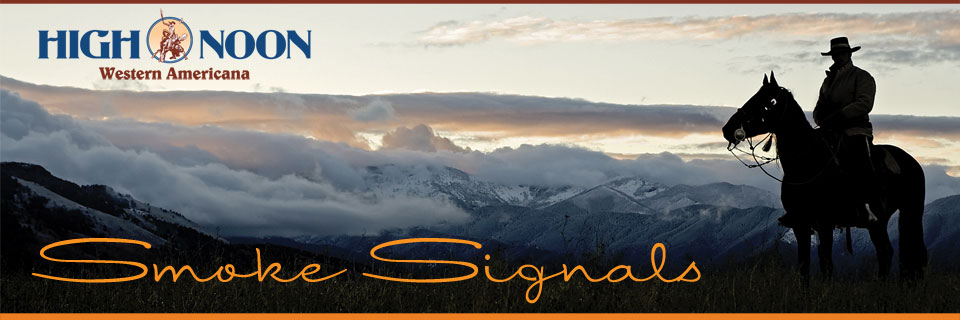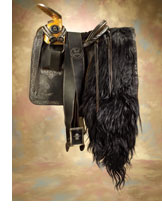
![]()
Taste and Collecting the West
By James H. Nottage
For some reason, I have been in a philosophical mood lately, reading some favorite old books and considering the broad world of Western American art and artifacts. Please indulge me for a short while.
 In certain circles, if you talk about culture and collecting, they think you mean French provincial furniture, English paintings, and maybe Meissen China. There is a definite snobbishness about art and antiques that has been prevalent for generations and it often centers around what someone else says has value and significance. Historically, the "important" arts have been from the lives of those in Europe or part of elite Eastern American society. In 1949, Russell Lynes authored an influential volume entitled The Tastemakers in which he talked about how collectors and the general public are influenced by a wide range of voices coming from museums, scholars, artists, decorators, designers, authors and many others. Each adds to the knowledge, insights, and even ambitions of the collector. Lynes concluded his book writing that "unless I completely misunderstand the real reason for having taste, it is to increase one's faculties for enjoyment. Taste in itself is nothing. It is only what taste leads to that makes any difference in our lives."
In certain circles, if you talk about culture and collecting, they think you mean French provincial furniture, English paintings, and maybe Meissen China. There is a definite snobbishness about art and antiques that has been prevalent for generations and it often centers around what someone else says has value and significance. Historically, the "important" arts have been from the lives of those in Europe or part of elite Eastern American society. In 1949, Russell Lynes authored an influential volume entitled The Tastemakers in which he talked about how collectors and the general public are influenced by a wide range of voices coming from museums, scholars, artists, decorators, designers, authors and many others. Each adds to the knowledge, insights, and even ambitions of the collector. Lynes concluded his book writing that "unless I completely misunderstand the real reason for having taste, it is to increase one's faculties for enjoyment. Taste in itself is nothing. It is only what taste leads to that makes any difference in our lives."
 When Lynes wrote his book, the very idea that art and artifacts of the American West had significance or should be given space or consideration in private collections of consequence or museums of national significance was seldom considered. At best, American Indian art had a place in museums of anthropology or natural history, Western paintings and sculpture were seldom seen, and silver-mounted cowboy spurs or tooled leather saddles were relegated to the back-waters of local museums in the "wild West." Western art in the broadest sense was but a contradiction in terms and any collector with a healthy bank account was wasting their time and money unless they were buying from galleries or auction houses in New York, Philadelphia, or Boston. If they were buying American at all, it pretty much had to be of and about the elite East.
When Lynes wrote his book, the very idea that art and artifacts of the American West had significance or should be given space or consideration in private collections of consequence or museums of national significance was seldom considered. At best, American Indian art had a place in museums of anthropology or natural history, Western paintings and sculpture were seldom seen, and silver-mounted cowboy spurs or tooled leather saddles were relegated to the back-waters of local museums in the "wild West." Western art in the broadest sense was but a contradiction in terms and any collector with a healthy bank account was wasting their time and money unless they were buying from galleries or auction houses in New York, Philadelphia, or Boston. If they were buying American at all, it pretty much had to be of and about the elite East.
 Russell Lynes does an amusing job of exposing the foibles of "tastemakers" who are the elite "highbrows". He skewers them, but also says more than a few words about those of low-brow status, with interests in popular culture. After more than three hundred pages, he acknowledges that we are constantly told that "there is good taste and bad taste, and that nearly anybody who tries hard enough and is diligent enough can have good taste." He points out that "nobody ever tells us what good taste is, for a very good reason. Nobody can define what it is." His conclusion? Lynes decided that taste comes from a number of factors, two in particular. First is education, both formal and informal and through environmental influences. The second source is sensibility defined by Webster's as "the ability to perceive or receive sensation."
Russell Lynes does an amusing job of exposing the foibles of "tastemakers" who are the elite "highbrows". He skewers them, but also says more than a few words about those of low-brow status, with interests in popular culture. After more than three hundred pages, he acknowledges that we are constantly told that "there is good taste and bad taste, and that nearly anybody who tries hard enough and is diligent enough can have good taste." He points out that "nobody ever tells us what good taste is, for a very good reason. Nobody can define what it is." His conclusion? Lynes decided that taste comes from a number of factors, two in particular. First is education, both formal and informal and through environmental influences. The second source is sensibility defined by Webster's as "the ability to perceive or receive sensation."
Well, since publication of The Tastemakers, the best of Western art and artifacts have made their appearances in important museum exhibits in Boston, New York, Washington, and elsewhere. Unheard of prices have been reached in public sales in the East, but increasingly at auctions in the West itself. Of course, news reports of record prices are often accompanied by gasps of disbelief from the "high-brows" that Western art cannot be worth that much. The reporters still question the taste of the buyer. By comparison, a $200,000 Western saddle cannot possibly be worth as much as a New England chest of drawers!
My favorite quote from Russell Lynes goes to the heart of what I believe. He wrote that "through the story of our taste has run a constant theme-if America is to be great, America must have culture." America has been host to and producer of great works of many kinds from paintings, to music, to film, to literature. What is more uniquely American and more telling of the diversity and lives of Americans than those works that are part of or reflective of the American Western experience? American culture thrives where the most stimulating thought is found in the passions of artists, collectors, museums, authors, and others. It does not thrive where one form of art is derided by another that tries to assure you that it is superior. It thrives if you consider the elements of taste emphasized by Lynes. Educate yourself about what you collect and how it relates to the rest of the world. Learn the sensibilities that allow you to be a connoisseur, to perceive and judge the quality of the objects you behold. Above all, do not bother to collect if you cannot see beyond the art as a commodity. What taste should lead to is the ability to enjoy those things we are passionate about. It is not a question of price. Become your own tastemaker, know your subject, and know the true markers of quality.
James Nottage
Chief Curatorial Officer, Eiteljorg Museum, Indianapolis, Indiana
Founding Curator, Autry National Center, Los Angeles
Husband of Mary Ellen Hennessy Nottage
If problems with website occur, please contact the webmaster. Site designed by Ireland Graphic Design.
